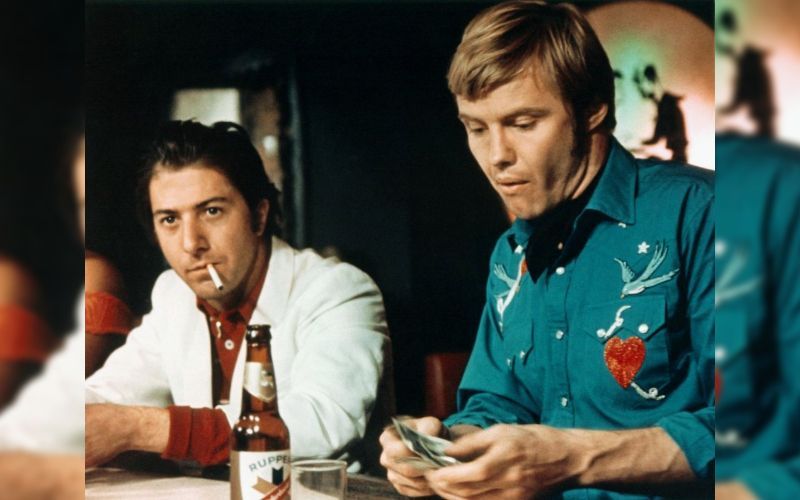Why every gay film buff should watch Midnight Cowboy
Celebrating a movie that helped to make it possible for Hollywood to tell the stories of gay men.

It’s just over 50 years since the queer classic Midnight Cowboy was released, but how does the film stand up today, given that it was made when the world was a very different place?
The short answer is that it’s still a great film, and well worth watching.
The plot
Texan Joe Buck is a good-looking, naive young ‘cowboy’ who heads for the bright lights of New York City to become a hustler – believing that rich women will fall at his feet.
By chance, he meets Enrico Rizzo – known to everyone as Ratso. Ratso is a small-time conman with a limp and poor health.
Ratso offers to become Joe’s manager, in return for a cut of the takings.
But things don’t quite go to plan, and the two begrudgingly become friends – living together in a decrepit squat, trying to make enough money to travel to Florida where they plan to start a new life in the sun.
What’s it really about?
The screenplay was written by Waldo Salt – adapting the 1965 novel of the same name by James Leo Herlihy.
John Schlesinger, who directed the film, was a fan of the novel. Schlesinger was a gay man from London, and his career was gaining momentum. The story of Midnight Cowboy was not something that Hollywood studios would normally consider for a film.
Salt’s adaptation left out much of Joe’s backstory, the crucial elements of which are hinted at in the film through strategically placed flashbacks.
At its heart, Midnight Cowboy is a quintessential buddy film – an odd couple, thrown together by circumstances, undertaking a journey together. There’s elements of Mark Twain’s storytelling at play, as time and time again we see Joe demonstrating that he has a good heart, that fundamentally he’s a good person, despite everything that’s happened to him and despite everything that he’s endured.
Loneliness is also a key theme – the film documents how loneliness can drive us to make questionable choices, to do things that take us into uncharted territory.
What makes it queer?
While Herlihy’s novel goes into more detail about Joe’s sexuality and earlier sexual experiences, Schlesinger’s film presents him as a bit sexually ambiguous.
Joe sees himself as a great lover of women, but he has sex with men to earn the money needed to survive.
The film gives us glimpses into the queer fabric of New York City at that time – the bars, the hustlers, the parties. While we may not immediately identify with the way that queer people are presented in the film, they are clearly visible.
The queerness of Midnight Cowboy was an essential step in breaking down the barriers of the celluloid closet.
The city
Midnight Cowboy is also recognised as a great New York film.
Schlesinger’s background was in documentary film-making. He wanted to create a vivid picture of the seedier side of New York, as it was. The film was made pre-gentrification and before the clean-up around Times Square and 42nd Street.
Some of the scenes were shot with hidden cameras, and many of people in the streets were passers-by rather than extras.
Schlesinger had met Andy Warhol in New York. The film includes a Warholian loft party that features a number of people from Warhol’s circle at The Factory.
The cast
Joe Buck is played by Jon Voight while Ratso is played by Dustin Hoffman.
The success of the movie rests completely on these two characters, and their uneasy and uneven relationship. Both Voight and Hoffman were nominated for the Oscar for Best Actor for their performances in this film.
These are landmark performances from actors at the beginning of their careers. Hoffman, in particular, delivers a powerhouse performance that is undeniably brilliant.
The director
Born in 1926, and educated at Oxford, John Schlesinger took an interest in film-making from a young age. Beginning as an actor, but soon moving into production roles and directing.
Before Midnight Cowboy, Schlesinger had made a name for himself with his 1965 film, Darling. It starred Julie Christie. Schlesinger had been nominated for an Oscar for the film, and Christie had won the top acting prize.
Schlesinger went on to enjoy a long and productive career, in film, television, and theatre.
He died in 2003, aged 77.
The music
The soundtrack to Midnight Cowboy was supervised by John Barry.
Nilsson’s heart-rending performance of ‘Everybody’s Talkin’ written by Fred Neil, won a Grammy for Best Contemporary Vocal Performance.
It’s an iconic track that provides an essential foundation to the film.
The reception
Due to what was deemed a ‘homosexual frame of reference’ by the censors, Midnight Cowboy was given an X rating in the US.
The film won three Academy Awards – Best Picture, Best Director, and Best Adapted Screenplay.
In the UK, Midnight Cowboy won six BAFTAs – Best Film, Best Direction, Best Actor in a Leading Role (Dustin Hoffman), Best Screenplay, Most Promising Newcomer to Leading Film Roles (Jon Voight) and Best Editing (Hugh A. Robertson).
The legacy
Midnight Cowboy was one of a number of films from that period that marked a cultural change in American film-making and a shift to films that portrayed different lifestyles, with grittier and more realistic story-lines.
People on the margins of society, pursuing their dreams, living on the edge of desperation were nothing new, but seeing these stories on the big screen was.
Midnight Cowboy is a masterpiece from a queer filmmaker – it captures the harsh reality of life and celebrates the resilience of the human spirit.